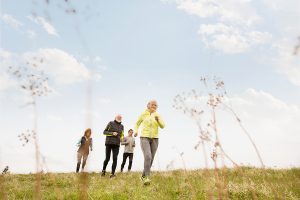 Do you find it’s harder to get out the door to exercise when the weather’s so cold? Even here in sunny Arizona it’s been below 50 and rainy! (Well, that was only one morning…) The regular “snowbirds” have arrived back from northern states and Canada. They complain about horrible snow and icy temperatures they left back home.
Do you find it’s harder to get out the door to exercise when the weather’s so cold? Even here in sunny Arizona it’s been below 50 and rainy! (Well, that was only one morning…) The regular “snowbirds” have arrived back from northern states and Canada. They complain about horrible snow and icy temperatures they left back home.
The dilemma? No matter where you live, “cold” is a relative experience. If you are used to 80 degree golf and tennis weather, going out the door in a chilly 45 degrees is hard. Personally, I’d rather be too hot than cold. How can active seniors manage cold weather exercise?
Cold Is Good for Us
For seniors who can’t escape to the south, cold weather exercise actually has advantages for senior health. If you can get outdoors, exercising in the cold increases energy. Not only that, it decreases tension, frustration, and depression, according to research published in Environmental Science & Technology.
According to adventure-fitness consultant Sean Burch, who set a world record running a marathon at the North Pole, “The heat and humidity in the summer can drag you down and tire you faster, but cold weather is invigorating,” he says. “It stimulates your senses, tunes you into your surroundings—it makes you feel alive.”
The Science of Cold Weather Exercise
There’s a biological reason for that: All exercise increases your levels of feel-good hormones and neurotransmitters such as serotonin, dopamine, estrogen, and progesterone. Hormones and neurotransmitters act to increase feelings of well-being.
Your body works harder in the cold, boosting hormone and neurotransmitter production, and contributing to a happier state of mind. Plus, exposure to natural light fights depression, especially for seasonal affective disorder, a condition caused by the shortened, dimmer days.
Obviously, no matter what the temperature is, exercise and fresh air are crucial for your body. But who wants to leave a warm and cozy house when it’s chilly outside? If you struggle with motivation, try these pro-active tips.
Bundle Up for Cold Weather Exercise
For any senior, cold weather preparation is critical.
- Dress in layers.
- Carry an empty backpack so you can remove layers and keep your hands free.
- Wear undergarments (silks or thermals if needed).
- Use a scarf or tube around your neck, face and ears. For extreme cold, check out the latest in high-performance cold weather headwear. Some form-fitting design envelopes the face, neck, and head, and prevents eyewear from fogging.
- Try mittens, rather than gloves, to keep your fingers warm.
- Don’t forget to layer your socks. I like wool for breathability, warmth and comfort; others prefer thermal, wool-blend or newer technology fabrics. Either way, make sure your footwear isn’t too tight, slowing down your circulation.
- Make certain that your outerwear is tested for cold, wind, and is waterproof.
Ideally, all your clothing should be breathable, but the main objective in cold weather training is keeping yourself warm enough.
A waterproof outer jacket may keep you dry from the outside, but over multiple layers it may hold in too much heat and cause sweat to pool. Knowing when to take off a layer is key.

Recent Comments